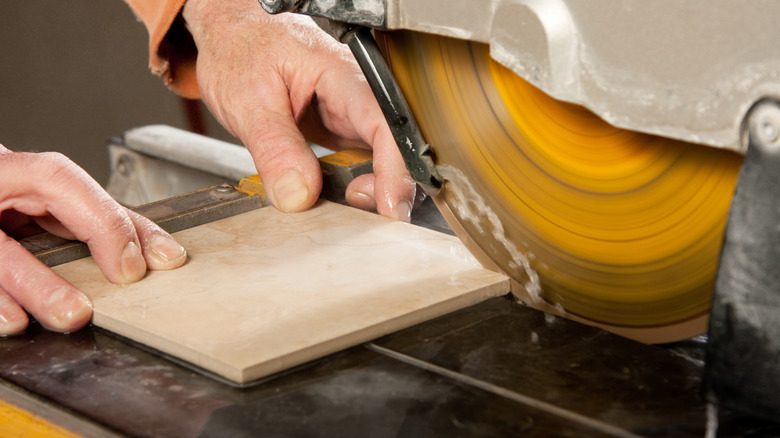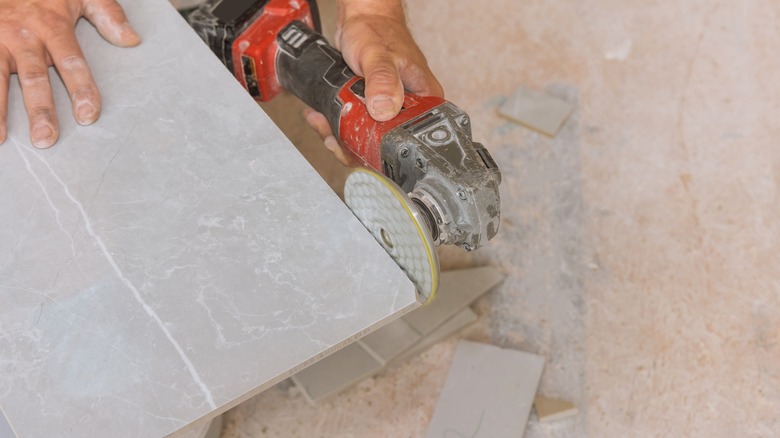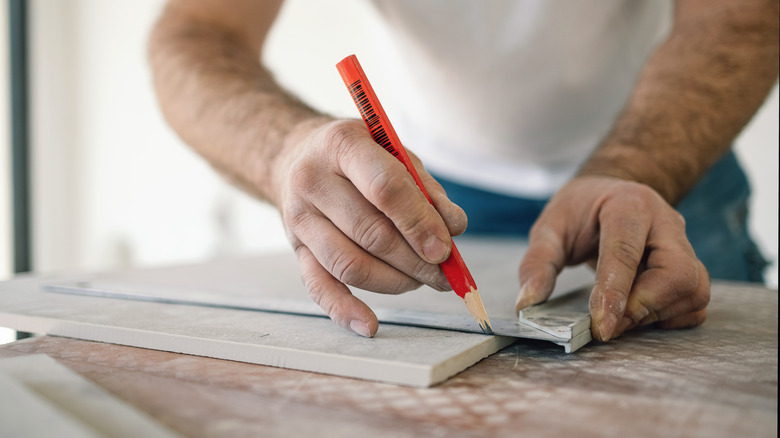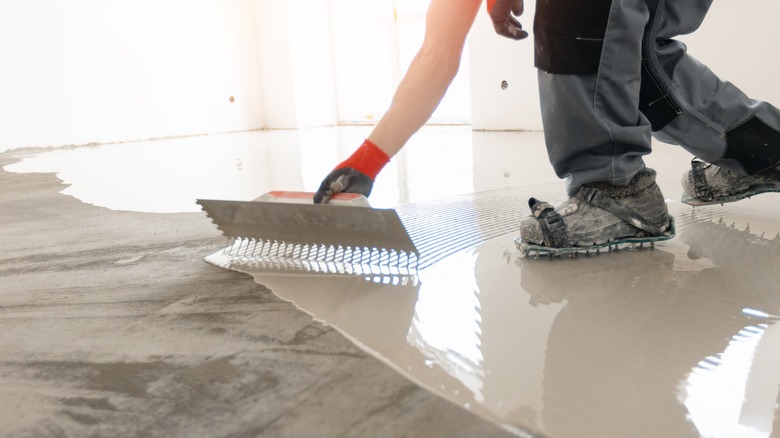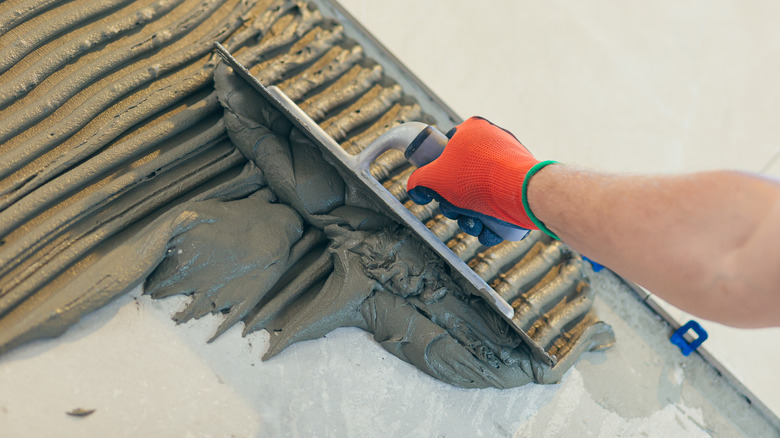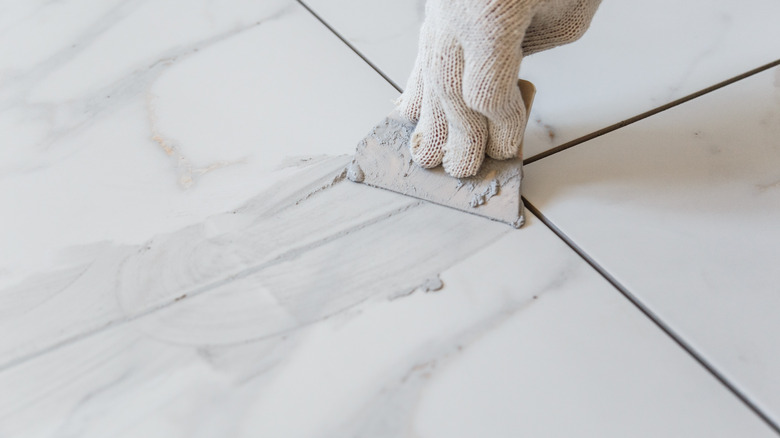Must-Know Tips For A Perfect Tile Floor Installation
Tiling a floor is not the simplest of DIY tasks. The job demands a narrow focus on the tile you're handling, so you can't see the full picture at all times. As a result, errors are easy to make — and almost impossible to rectify once the mortar has set. For instance, misaligning the tiles by a fraction of an inch can skew the entire layout. Likewise, your chosen design or color may look stunning on your computer screen, but disappoint you once you step back and look at the finished floor. What's more, cutting tile, troweling mortar, and grouting are all tricky tasks that can quickly botch your project if not done correctly.
Now, no amount of expertise or experience can make a floor tiling project a "breeze." These projects are inherently tough and tedious. But, with adequate knowledge, you can avoid tiling errors and the costly fixes they entail. To make your floor tile installation less taxing, we've put together a list of handy tips. Our advice includes best practices for choosing the right materials, getting an accurate estimate, and handling the tiles properly. We've also shared a few thoughts on choosing the best design and layouts for your new tiled floor.
Choose the most suitable tile design and layout for your space
Your chosen tile size, design, and layout should be harmonious with each other and the room they're in. Achieving this harmony can be tricky, as not all tile designs work well in a given space. A good starting point is to consider the size of the room relative to tile dimensions. Layouts that result in a narrow grid of grout lines make a room look smaller. Conversely, having fewer lines on the floor creates a visual illusion that a space is larger than it is. To this end, use larger tiles in rooms with the smallest footprint, such as bathrooms or hallways. Moreover, opt for plain-looking tiles if you're trying to create a complex layout, and reserve the more ornate tiles for minimalist patterns.
When choosing a layout, think about the aesthetic you're trying to create with your floor and decide if it will work with tiles you've picked. For example, you can add some oomph and individuality to a small bathroom using plain, square tiles in a diamond or checkerboard pattern. Moreover, this tile pattern is excellent for a bathroom, because it will also make the space look larger. On the other hand, a running bond pattern with plain, rectangular tiles will visually correct an uneven floor surface. Meanwhile, a more elaborate pattern, like octagon and dot, is an apt choice for recreating a classic yet vintage look in your home.
Calculate how much tile you'll need to reduce trips to the store
Buying fewer tiles than your project demands could translate to last-minute shopping trips and even the nightmare scenario where the tiles you need to finish your job are sold out. On the other hand, splurging on more tiles than you need could be a waste. So, before you start your project, find out exactly how much tile you'll need.
Drawing up a tile estimate is relatively simple. Start by calculating the area of the floor that needs to be tiled. You can do this by multiplying the length of the room by its width (in feet). If the room's design isn't perfectly square or rectangular, divide it up into several rectangles, calculate their areas, then add them all together. Once you've established the area of the space, go ahead and count how many tiles you need to fill it. Multiply a tile's length by its width (in inches) to get its area, then divide this number by 144 — this gets you the area of a single tile in square feet.
At this point, divide the previously established floor area of the room by the area of a single tile. This final calculation will leave you with the number of tiles needed to cover the floor fully. Mr. Handyman recommends getting 10-20% more product than needed to allow for broken tiles and to cover parts of the floor that need smaller bits of tile.
Use the 3-4-5 rule to line up your tiles perfectly
Before you lay the tiles, it's wise to plot two perpendicular chalk lines on the floor to line up the tiles squarely with the room's walls. To ensure the accuracy of the two chalk lines, you can use what's known as the "3-4-5 rule." This rule is based on the Pythagorean Triangle. This geometrical concept states that if a triangle's side lengths are 3, 4, and 5 (regardless of the unit of measure), the shape is a right triangle. This means that its two perpendicular sides converge at a 90-degree angle — and that's the angle at which your two chalk lines should intersect.
To apply the 3-4-5 rule, start at the intersection between the two chalk lines. Measure 4 feet from the intersection along one of the lines, and mark the spot. Starting the measuring tape at this new spot, pull it out to 5 feet, then walk and see where it intersects on the perpendicular line, and mark this location. If the distance between this final mark and the two lines' intersections measure 3 feet, give yourself a pat on the back. You've got a right triangle, and your tile layout will line up with the room's walls. If your measurements are off with the currently-drawn chalk lines, you'll have to redraw them until the 3-4-5 rule checks out. Don't start laying tiles until you've confirmed that the two chalk lines intersect at a right (90-degree) angle.
Notch ceramic tiles to avoid chipping when sawing with power tools
All tiles will occasionally chip when you cut them with a power tool. Porcelain tiles (which you'd normally use in busy areas like bathrooms or hallways) are notably vulnerable to chipping when being cut due to their density and brittleness. The chipping can occur if you apply too much pressure on the blade when cutting, or if the blade doesn't remain straight while you're cutting. To reduce chip-related damage to your tiles, notch them before you proceed with the cut. Making a notch first stabilizes the blade and allows you to make the cut using less pressure.
Making a notch in the tile is simple. Mark the spot where you want to make the cut. Then, use your wet saw to make a tiny cut in the material. With the notch in place, you can continue making the full cut along the length of the tile. As you cut, keep yourself from applying too much pressure or you still risk cracking or chipping the material.
Buff cut tile edges with the right polisher
Even with the most suitable saw blade and notches in your tiles, the cutting process will leave you with rough edges that have plenty of minor imperfections. These flaws may not seem like a big deal when you're sawing the tiles, but you'll see them (and never unsee them) once you've finished the job. Moreover, the sharp edges may pose a safety hazard when you're handling the tiles. To avoid ending up with an amateur-looking floor and cuts on your hands, it's best to smooth the tile edges after cutting.
To smooth the edges, you can use a variety of methods and tools. Good old sandpaper is the simplest (and cheapest) of these. According to Z-Lion, it's best to start with a grit between 120 and 200 — it's coarse enough to remove the imperfections, but fine enough to preserve the tile finish. However, you may want to use a sanding block instead of holding the paper in your hands to avoid breaking the latter and possibly cutting yourself on the tile edge. Alternatively, use an emery cloth before switching to the sandpaper. Emery cloths are tough enough to quickly file down the sharp edge of the tile and while protecting your hands from nasty cuts.
Avoid making cuts smaller than half a tile
According to the Ceramic Tile Education Foundation, cuts smaller than half of the tile's standard size are a recipe for a chaotic, unprofessional-looking floor. Partly, that's because the cuts you make will never be perfect — no matter how hard you try. And despite your best efforts, they'll also vary a bit in size. You may overlook this flaw while cutting, but the inconsistent sizes will become quickly apparent once you lay these small pieces next to standard-sized tiles. Even a well-laid-out floor will attract negative attention if small bits of tile exist somewhere in the layout.
That said, you'll almost certainly have to cut some tiles to make your design work. To avoid drawing unwanted attention to these tiles, keep them to at least half their standard size. This way, they'll blend in more seamlessly with their full-sized peers. Of course, if you're planning an intricate pattern that demands tiny bits of tile, you can disregard the rule above and still end up with a stunningly gorgeous floor. But this is a rare instance of curated chaos that doesn't apply to most DIY home tiling projects.
Keep cut tiles around the perimeter
If you're using small pieces of tiles you've cut, do so around the room's edges — not in the center. While cutting tiles to at least half their original size is the best practice, it's not always feasible. For example, you may be stuck with a tile shape or dimension that won't cover the floor completely if you follow this rule. If this is the case, don't mess up your otherwise organized layout with these thin strips of tile. At the very least, don't place these bits where they would be too visible, like the center of the room, or sandwiched between two full-sized tiles.
The Ceramic Tile Education Foundation recommends banishing pieces of cut tile to the room's perimeter. Keeping cut tiles at the edges of the space preserves the layout at the center, where it's most obvious. Additionally, laying these odds and ends right beneath the walls gives you an opportunity to make them less intrusive. For example, your baseboards will conceal the tiles' imperfect shapes and other imperfections you may have inflicted on them with the saw. Likewise, the furniture you place along the room's walls will help keep these tile fragments out of sight.
Use a self-leveling compound to make the floor smooth
You won't always have a perfectly even subfloor when laying tile. When the floor is anything but smooth, you'll likely have a hellish time installing your tiles. What's worse, uneven subfloors are one of the primary causes of tile lippage, according to Downright Tile and Renovations. Lippage is not just an aesthetic issue. Apart from the unsightliness, this problem makes tile floors difficult to walk on — you can easily injure your feet on the protruding edges and corners. Applying a self-leveling compound to the subfloor gives you a quick, effective way of preventing tile lippage and simplifying installation.
A self-leveling compound is a type of fluid, cement-based mixture that levels a floor's imperfections by settling in its lowest spots. It comes as a powder you must mix with water before pouring it onto the subfloor. Once poured, you can trowel the mix to create a smooth surface. Most harden within half an hour or so, so you'll need to finish the entire floor area quickly.
While the steps above work for most of these leveling mixes, application instructions may vary between different brands. For example, some compounds need you to make the subfloor wet before application. The products may also have different water ratios and setting times. Following these instructions carefully ensures you don't end up with a low-quality base for your tiles.
Choose the correct trowel for the project
Different tile sizes require different amounts of mortar (either mastic or thin set) beneath them. Generally, larger tiles require adhesive applied in deeper ridges, and vice versa. This way, the tiles get sufficient thin set coverage and bond to the substrate correctly. To ensure your tiles get enough mortar, you'll have to use a properly-sized notched trowel. Here, "size" refers to the depth and width of the trowel's notches (also called "teeth"). Likewise, you'll have to consider the configuration of the teeth, which come in V, U, and square shapes.
Per Contractors Direct, you can prepare the substrate for mosaic tiles (or those measuring less than 4 inches) with V-notch teeth as small as 3/16 of an inch. Meanwhile, slightly larger tiles of up to 8 inches in length need you to trowel the mortar with square teeth that are at least a 1/4 inch deep and wide. If you're working with massive tiles over a foot and a half long, opt for a trowel with 1/2-inch notches that are square.
Select the most suitable grout for your tiles
Grout is a mix that acts as a filler and sealant between tiles. Since it serves such a vital functional and aesthetic purpose, you should choose the grout type and color carefully. The ideal grout type depends on the tile size and material, while the color should complement the tiles and the surrounding space.
The two most common types of grout are sanded and unsanded. According to Lowe's, sanded grout is ideal for wider tile joints up to ⅝ of an inch. That's because the sand helps keep the grout mixture from shrinking too much when it dries — something you want to avoid with wide gaps between tiles. The presence of sand also makes this grout type more wear-resistant. That said, the sand is abrasive, and can scratch a fragile tile finish. On the other hand, unsanded grout leaves the tile surface unscathed, but forms a weaker joint that's more prone to shrinkage. Unless your floor tiles have gaps narrower than ⅛ of an inch, or have a very smooth, delicate surface, it's best to grout your tile with a sanded mix.
When selecting the grout color, consider the tile design, floor dimensions, and the aesthetic you're striving to create. Avoid too much contrast between grout and tile colors in spacious rooms, as the floor can overpower the room decor. On the other hand, smaller spaces could benefit from a bold design that features contrasting colors. Apart from aesthetics, think about how much foot traffic the floor will get and if it'll get dirty easily. For example, it may be wise to avoid light-colored grout in the mudroom or foyer.




